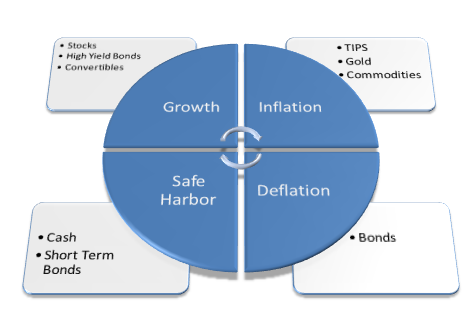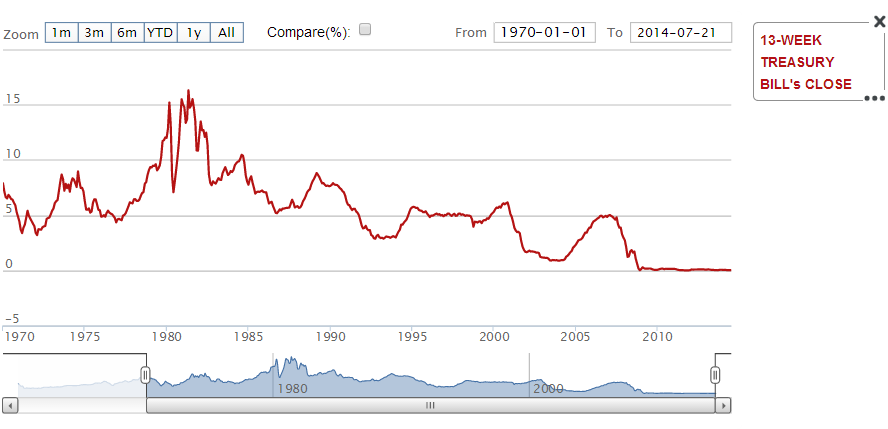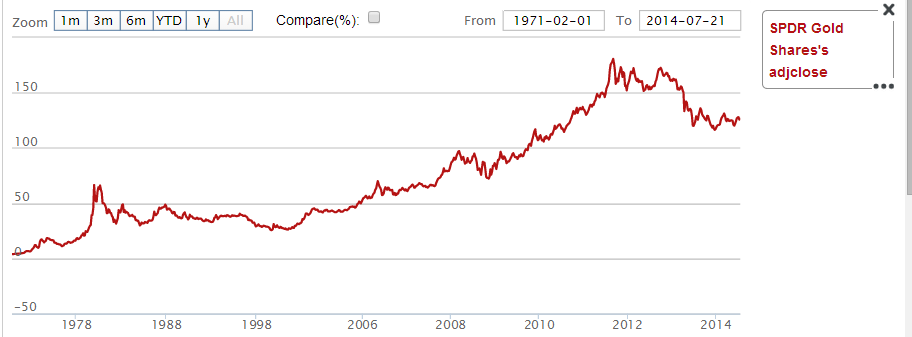Re-balance Cycle Reminder All MyPlanIQ’s newsletters are archived here.
For regular SAA and TAA portfolios, the next re-balance will be on Monday, August 11, 2014. You can also find the re-balance calendar for 2013 on ‘Dashboard‘ page once you log in.
As a reminder to expert users: advanced portfolios are still re-balanced based on their original re-balance schedules and they are not the same as those used in Strategic and Tactical Asset Allocation (SAA and TAA) portfolios of a plan.
Please note that we now list the next re-balance date on every portfolio page.
Permanent Portfolios & Four Pillar Foundation Based Framework
We introduced and discussed these portfolios several times in the past:
- February 25, 2013: Risk Parity All Weather & Permanent Portfolio Review
- August 6, 2012: Four Pillar Foundation Based Portfolio Review
In 2013, as both bonds and gold had trouble, these portfolios did poorly, compared with other more traditional stock and bond portfolios.
The latest performance (as of 7/21/2014):
| Ticker/Portfolio Name | YTD Return** |
2013 | 1Yr AR | 3Yr AR | 5Yr AR | 10Yr AR | 10Yr Sharpe |
|---|---|---|---|---|---|---|---|
| Bridgewater All Weather Portfolio Risk Parity | 5.4% | -3.3% | 5.3% | 4.4% | 7.0% | 6.4% | 1.36 |
| Bridgewater All Weather Portfolio | 6.3% | -1.6% | 6.8% | 5.1% | 8.9% | 7.9% | 1.21 |
| Harry Browne Permanent Portfolio | 7.3% | -3.8% | 6.9% | 4.3% | 8.1% | 7.6% | 0.93 |
| Permanent Income Portfolio | 8.0% | -0.2% | 7.0% | 7.1% | 9.8% | 6.9% | 0.98 |
| VFINX (Vanguard 500 Index Investor) | 7.9% | 32.2% | 19.1% | 16.8% | 18.3% | 8.1% | 0.35 |
| VBINX (Vanguard Balanced Index Inv) | 5.8% | 18% | 12.6% | 11.2% | 13.2% | 7.4% | 0.53 |
See the more detailed year by year comparison >>
Since the beginning of this year, these portfolios have largely recovered. In fact, many of them have outperformed VBINX (Vanguard Balanced Index Inv). Readers should also pay attention to their high Sharpe ratios and low maximum drawdown (loss) during the last two bear markets (click on the year by year comparison >> and look at the detailed comparison table) . By these risk adjusted metrics, these portfolios have done remarkably better than a simple stock and bond buy and hold portfolio.
Four Pillar Investment Foundation Theory
Permanent portfolios, all weather portfolios and other variants are all based on the four pillar framework:
The framework calls for balanced investments in each corner to hedge out each other while achieving a long term reasonable return.
Notice this framework is not only useful for constructing a buy and hold strategic portfolio such as a permanent portfolio, it is also very much a foundation for us at MyPlanIQ to construct a tactical portfolio. The key here is that one should have candidate funds to cover each corner so that a Tactical Asset Allocation strategy can take advantage of those assets that do well in each economic scenario covered in the corner. For example, we have maintained the following core asset classes:
- Growth: U.S. equities, intl. equities, emerging market equities, REITs
- Inflation: commodities, REITs
- Deflation: bonds
- Safe harbor: short term bonds & cash
All of these plans include funds to cover these core asset classes.
Stellar long term performance
Harry Browne Permanent Portfolio, a portfolio that allocates 25% each to stocks, gold, bonds and cash or short term investments, has a stellar long term performance. The following table on Long Term Harry Browne’s Permanent Portfolio Performance shows this portfolio’s performance since 1970:
| 1970 | 4.10% | 1980 | 22.10% | 1990 | -0.70% | 2000 | 2.70% | 2010 | 11.92% |
| 1971 | 13.40% | 1981 | -6.20% | 1991 | 11.50% | 2001 | -1.00% | 2011 | 8.16% |
| 1972 | 18.70% | 1982 | 23.30% | 1992 | 4.00% | 2002 | 7.20% | 2012 | 5.5% |
| 1973 | 10.60% | 1983 | 4.30% | 1993 | 12.60% | 2003 | 13.76% | 2013 | -3.8% |
| 1974 | 12.30% | 1984 | 1.10% | 1994 | -2.40% | 2004 | 6.64% | ||
| 1975 | 3.70% | 1985 | 20.10% | 1995 | 16.60% | 2005 | 8.01% | ||
| 1976 | 10.10% | 1986 | 21.70% | 1996 | 5.20% | 2006 | 10.80% | ||
| 1977 | 5.20% | 1987 | 5.30% | 1997 | 6.70% | 2007 | 11.94% | ||
| 1978 | 15.00% | 1988 | 3.60% | 1998 | 7.40% | 2008 | -2.03% | ||
| 1979 | 36.70% | 1989 | 14.80% | 1999 | 4.70% | 2009 | 9.64% | ||
| Cumulative | 328.62% | 272.57% | 186.24% | 190.27% | |||||
| Annual | 12.63% | 10.55% | 6.42% | 6.64% | Since 1970 | 8.68% |
Notice during the period (1977 to 1981), both short term and long term rates rose sharply:
while from 1980 to 2001, gold experienced a long bear market that saw its value dropped almost 2/3:
In 1981 where both long term bonds and gold experienced large loss, the permanent portfolio lost -6.20%, mostly offset by the stocks’ performance.
What’s ahead
At the moment, we have heard many concerns on
- Bonds: rates are bound to rise, given the current sub-zero rates. However, the question is whether long term rates will rise and if they do, how much. At the moment, globalization and de-leveraging have made deflation force last much longer. Precisely whether this will still go on for a year, five years or a decade, no one is for sure.
- Stocks: over valued and bound to fall at some point. Unless one believes stocks have entered ‘a permanently high plateau’, they will reverse to a lower point than today’s level at some point in the future. However, stocks can still go a lot higher
- Gold: over valued or under valued? no body knows for sure and no one has a way to value it. What one can count on is that its physical store value property will probably be still sought after during rampant inflationary or unstable periods.
Market Overview
The significant geopolitical events in Ukraine and Gaza have not affected investors’ risk appetite much. In fact, we now observe not only US stocks are at the record territory, emerging market stocks have shown considerable strength recently. However, both long bonds and gold are also showing a positive trend.
For more detailed asset trend scores, please refer to 360° Market Overview.
We would like to remind our readers that markets are more precarious now than other times in the last 5 years. It is a good time and imperative to adjust to a risk level you are comfortable with right now. However, recognizing our deficiency to predict the markets, we will stay on course.
We again copy our position statements (from previous newsletters):
Our position has not changed: We still maintain our cautious attitude to the recent stock market strength. Again, we have not seen any meaningful or substantial structural change in the U.S., European and emerging market economies. However, we will let markets sort this out and will try to take advantage over its irrational behavior if it is possible.
We again would like to stress for any new investor and new money, the best way to step into this kind of markets is through dollar cost average (DCA), i.e. invest and/or follow a model portfolio in several phases (such as 2 or 3 months) instead of the whole sum at one shot.
Latest Articles
- July 14, 2014: Composite Portfolios Review
- July 7, 2014: Portfolio Behavior During Market Corrections
- June 30, 2014: Half Year Brokerage ETF and Mutual Fund Portfolios Review
- June 23, 2014: Newsletter Collection Update
- June 16, 2014: There Are Always Lottery Winners
- June 9, 2014: The Arithmetic of Investment Mistakes
- June 2, 2014: Tips On Portfolio Rebalance
- May 26, 2014: In Praise Of Low Cost Core Asset Class Based Portfolios
- May 19, 2014: Consistency, The Most Important Edge In Investing: Strategic Case
- May 12, 2014: How To Handle An Elevated Overvalued Market
- May 5, 2014: Asset Allocation Funds Review
- April 28, 2014: Now The Economy Backs To The ‘Old Normal’, Should Our Investments Too?
- April 21, 2014: Total Return Bond Investing In The Current Market Environment
Enjoy Newsletter
How can we improve this newsletter? Please take our survey
–Thanks to those who have already contributed — we appreciate it.





 Diversified Asset Allocation Portfolios For Your Plans
Diversified Asset Allocation Portfolios For Your Plans
